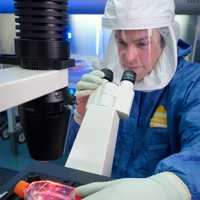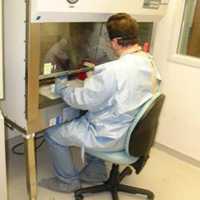
CDC laboratorian at work.
The Division of Preparedness and Emerging Infections (DPEI) works to build and strengthen public health capacity by enhancing the ability of CDC and its public health partners to prepare for, prevent, and respond to infections diseases, including outbreaks, bioterrorism, and other public health emergencies, through cross-cutting and specialized programs, technical expertise, and public health leadership.
Activities
In carrying out these activities, the Division:
- advocates for CDC programs, health departments, and other partners on issues related to emerging infections, bioterrorism, and public health resources;
- develops and implements infectious disease surveillance, laboratory, and capacity-building activities in collaboration with other CDC programs and external partners;
- works with infectious disease programs on processes for developing, awarding, managing, and evaluating infectious disease grants and cooperative agreements;
- provides scientific and programmatic leadership, as well as management, administrative, and technical support for broad infectious disease cooperative agreements such as the Emerging Infections Program (EIP) and the Epidemiology and Laboratory Capacity for Infectious Diseases (ELC) program;
- collaborates across CDC and with national and international partners to address the scientific and response planning and preparedness issues for bioterrorism, emerging infections, and other infectious disease emergencies;
-

Personnel at work during H1N1 outbreak.
provides the agency’s initial rapid response capabilities (including 24-hour, on-call emergency response coordination and epidemiologic and laboratory support) for bioterrorism and other infectious disease public health emergencies;
- conducts, supports, and evaluates activities aimed at identifying and reducing risk factors for infectious diseases among residents of the Arctic and Subarctic regions;
- maintains primary responsibility for development and management of the nation’s Laboratory Response Network (LRN), including supporting the development, deployment, and quality control of diagnostic reagents for the LRN laboratories;
- serves as a primary screening laboratory for CDC for specimens that may contain threat agents;
- analyzed the economic impact of infectious diseases in collaboration with other CDC infectious disease programs and collaborators outside the agency;
- leads and coordinates infectious disease fellowships and training programs;
- provides technical assistance and training on biosafety/biosecurity and bioterrorism agent detection and response to internal and external partners, including assistance with related public health and law enforcement investigations and planning for high profile national and international events; and,
- assists in medical countermeasures response and utilization coordination.
Organizational Structure

Lab testing.
DPEI is composed of an Office of the Director and four branches and a specialty unit:
- Arctic Investigations Program
- Emergency Preparedness and Response Branch
- Laboratory Preparedness and Response Branch
- Scientific Program Services Branch
- Health Economics Modeling Unit
- Page last reviewed: April 24, 2015
- Page last updated: April 29, 2015
- Content source:


 ShareCompartir
ShareCompartir